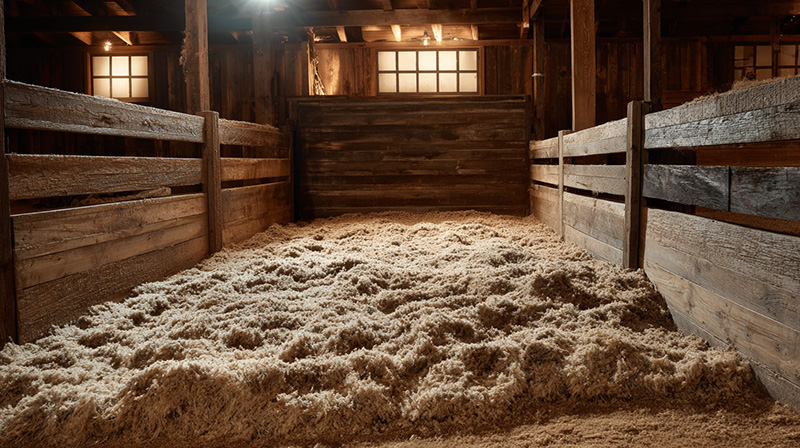Bedding Basics: Why Comfort Matters
Ever wonder why horses need bedding at all? Think of it as the mattress, carpet, and air-filter for your equine roommate. Good stall bedding insulates muscles from hard surfaces, absorbs urine to limit ammonia, and traps dust before it drifts into lungs.
In crowded barns, that small layer of cushion helps joints, reduces sores, and keeps animals exposed to fewer pathogens boosting overall health and well being. It also lets tired athletes enjoy true adequate rest, while smart fibers absorb moisture so you’re not mucking puddles twice a day.
A calm, clean environment starts right under their hooves.
Meet the Materials: An Overview
When you compare stall materials, quality starts with the raw fiber. Below, we review certain bedding materials for absorbency, particle size, and particulate content so every reader can decide with confidence.
The common types include wood shavings, wood pellets, loose straw, peat moss, shredded paper, and more. We’ll explore these different types in detail, but remember: only some options prove truly suitable as proper bedding for performance mounts.
Wood Shavings in Focus
Ask ten riders what smells like home and nine will answer “fresh wood shavings.” These feather-light curls of wood come in everything from micro to larger flakes.
Bigger pieces form a soft cushion while smaller ones pack tighter and absorb moisture faster perfect for dawn muck-outs. Many experts recommend premium shavings free from black walnut or red maple, as toxins from those species can damage hoof health and overall quality.
Screening removes extra dust, but even clean shavings pair best with stall mats that keep them from drifting into cracks. Used right, shavings remain classic horse bedding for comfort, value, and familiarity.
Pelleted Power: Wood Pellets and Beyond
Short on space but big on cleanliness? Wood pellets could be your secret weapon. These tiny cylinders of compressed wood expand when dampened, morphing into a fluffy, absorbent base that rivals fine shavings for odor control. Because pellets start dense, you can store twice the volume in half the footprint ideal for event tack rooms. Some caretakers sprinkle dry pellets in wet spots; others rely on full-bed installs of pellet bedding. Premium sawdust wood pellets are heat-treated to curb microbes while trapping rank moisture for days smart, simple, and show-ready.
Straw Bedding Revisited
Classic straw bedding still has plenty of fans among horse bedding traditionalists. Clean wheat or oat straw offers a bright, airy look that photographs beautifully, and its hollow stems wick surface moisture surprisingly fast.
Because strands interlock, they stay springy under heavy horses, adding bounce without excess dust. If you source locally, inspect every bale for mold, sharp awns, or stray bits of red maple that could ruin quality.
Peat Moss, Paper & Other Niche Choices
Battling deep mud or persistent odors? Specialty fillers like peat moss can tip the scales. Fine-ground peat creates a dark, sponge-like pad that ranks among the most absorbent products available.
Another sleeper hit is shredded paper virtually zero dust and great for horses coping with allergies or chronic respiratory issues. Both break down quickly, helping the surrounding environment and making haul-off cheaper.
They’re also light to store in lofts. Rotate them with shavings to stretch bedding quality and your wallet.
Dust Control for Respiratory Health
Tiny particles from low-grade mixes can spark coughing fits or, worse, inflammatory airway disease. Aim for kiln-dried wood shavings or screened wood pellets processes proven to slash airborne dust. Shake the bag; if a cloud blooms, walk away.
Wet new shavings lightly so moisture binds stray motes without turning the floor to sludge. Maintaining bedding quality here is critical: low-dust horse bedding can be the difference between a quiet night and a hacking cough.
Moisture Management and Stall Mats
Liquid trouble begins at floor level, so winning the moisture war starts with drainage and stall mats. Dense rubber mats raise the bed slightly, channeling wetness away from the base and cutting your shavings bill by a third.
Many horse stalls we outfit pair mats with either wood shavings or wood pellets, creating a layered, absorbent system while maintaining superior quality. Less time bent over a fork means more minutes watching your athlete stretch, stand, and relax.
Dry horse bedding also discourages flies, delivering a fresher environment for everyone.
Protecting Hooves and Joints
Soundness starts from the ground up. A forgiving layer of stall bedding spreads load across the frog and heels, shielding a horse’s hooves from bruising. That support, plus gentle give, encourages circulation essential to lasting hoof health.
Many trainers swear that deep wood shavings or blended absorbent bedding are recommended for horses rehabbing from stone bruises.
Consistent footing reduces joint stress, reinforcing overall health and well being. With regular muck-outs your partner will stride from the stall as springy as they walked in.
Sustainability Inside and Outside the Barn
Eco-smart choices protect both budget and planet. Locally milled wood products or baled straw cut trucking emissions, while materials like peat moss or fine sawdust break down swiftly into compost, turning waste manure into garden gold.
This loop offers several advantages less material to haul away, cleaner showgrounds, and a healthier environment. Keep an eye on incoming load quality; clean, low-ash bedding decomposes faster and won’t lead to nutrient imbalances in soil.
Putting It All Together in Your Program
So what’s the best bedding routine? Start by ranking priorities, budget, hauling limits, local supply and match them to the types of bedding we’ve covered.
A base of kiln-dried wood shavings, topped with a sprinkle of wood pellets in wet zones, often balances cost with performance while maintaining unbeatable quality. Keep a stash of peat moss handy; it’s easy to store and bails you out during surprise storms. Rotating mixes lowers dust and lengthens the life of your horse stalls.
Tracking usage stats on your equine bedding will spotlight savings, and switching horse bedding brands seasonally keeps all horses comfortable. Thoughtful tweaks can create an inviting space that supports peak performance year-round.
